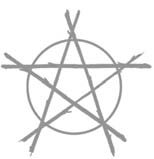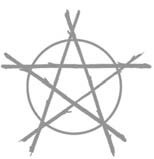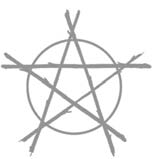Read To Walk a Pagan Path: Practical Spirituality for Every Day Online
Authors: Alaric Albertsson
Tags: #Reference
To Walk a Pagan Path: Practical Spirituality for Every Day (34 page)

the “nameless thousands whose blood, deeds and luck
flow within us.” The offerings can be anything those
f 258 2
yule
ancestors might enjoy, but Nick often gives a libation of
mead or some other fermented drink.
• December 28th: Hel’s Night. In Germanic traditions,
Hel is both a place and the goddess who reigns over
that place. It is not a particularly bad place, nor is the
goddess Hel (or Hella) a particularly bad goddess. Nick
gives her offerings of mead, bread and meat.
• December 29th: Ygg’s Night. Ygg is another name
for the god Oðinn, and this night is dedicated to him.
The votive offering is always mead or some similar fer-
mented drink, and Ygg is praised as the god who won
the runic Mysteries.
• December 30th: Thunderer’s Day. This day is dedicat-
ed to the god Thor, who is known to Saxon Pagans as
Thunor. In Nick’s devotional liturgy he is addressed
as “You who defend the Midgard, who are Friend to
All Men, whose laughter sounds like the roll of thun-
der.” Beer is the usual offering, but Nick tells me that he
might also (or instead) give this god meat or bread.
• December 31st: Twelfth Night. On the last night of the
year Nick and his household honor the Norns, three
powerful spirits who shape the fate of men. Fermented
drink is the usual offering.
Obviously this is a much more structured approach to
celebrating twelve days of Yule, and Nick admits it requires
a willingness to adapt to worldly demands at times. This past
year, he tells me, “We had to be flexible on one or two nights
due to geography and timing. We traveled back to Columbus
(Ohio) on Christmas Eve to be with my family, and thus we
f 259 2
yule
couldn’t really do the devotionals as originally planned; but
we made it work.”
If you understand that plans may need to be changed, a
structured twelve day celebration may appeal more to you.
This could be a series of twelve rituals, as Nick has done,
or your tribe may want to alternate rituals with wassailing,
feasting or other Yuletide activities. The right way to do this is whatever way is both true to your spiritual tradition and
fulfilling to you and your folk. When celebrating the twelve
days of Yule the important thing is not what you do or when
you do it, so long as you do
something
throughout this twelve day period of transition from one year to the next.
For those of us living in the northern hemisphere, the
Yuletide brings another year to an end. And then a new year
begins, unfolding before us as we walk a Pagan path.
f 260 2

GLOSSARY
Alfar:
A class of male ancestors that guard or watch over the inherited land of their descendants. (Norse)
Ásatrú:
Icelandic Paganism. This term is sometimes used in a more general way to include all Germanic paths, especially Scandinavian paths.
Beltane:
A festival celebrated on or near the first of May, marking the beginning of summer. (Irish Celtic, Wiccan)
Blót:
A sacrifice to the gods or ancestors. The word literally means “blood”, but Norse Pagans generally use the term
for any offering. (Norse, Saxon)
Calan Awst:
A festival celebrated on or near the first of August, marking the beginning of the harvest season.
(Welsh Celtic)
Demos:
A name used by many Hellenic Pagans for the tribe or spiritual family. Plural,
demoi
. (Hellenic)
f 261
f
2
261
glossary
Dodekatheon:
The twelve Olympic gods and goddesses of the Hellenic Pantheon. (Hellenic)
Dvergar:
An Old Norse word for dwarves, subterranean spirits associated with metals and gems, craftsmanship and
wisdom. (Norse)
Eormensyl:
The Axis Mundi that connects the Seven Worlds of Anglo-Saxon cosmology. Sometimes called the “World
Tree”. (Saxon)
Esbat:
A coven meeting that takes place at some time other than one of the sabbats. Esbats are usually held on or near
the full moon. (Wiccan)
Gallic:
Coming from or originating in Gaul, a region of Europe that roughly corresponds to the modern nation
of France. Gallic Pagans revere continental Celtic deities
such as Taranis, Ogmios and Lugus.
Gesith:
An oathed member of an inhíred, sworn to brother-hood. The word literally means comrade or companion.
Plural,
gesithas
. (Saxon)
Hal Sidu:
Old English for “healthy (hale) custom”. Holistic traditions that bring together the body, mind and spirit.
Hama:
The astral body that surrounds and protects the physical self. As a proper noun this is also the name of the god
known to the Norse as Heimdall. (Saxon)
Hausvættir:
Another term for house elves. (Norse)
Hellenic:
Relating to the ancient Greeks. Hellenic Pagans revere the deities of the Dodekatheon with reconstructions of ancient Greek ritual.
Híredmann:
Any member of an inhíred, oathed or not. Plural,
híredmenn
. (Saxon)
f 262 2
glossary
Húsel:
A sacrifice to the gods or ancestors. (Saxon)
Imbolc:
A festival celebrated on or near the first of February, marking the beginning of spring. It is associated with the
lactation of ewes in early spring. (Irish Celtic, Wiccan)
Inhíred:
The tribe or extended family. The name means
household. Plural, inhírdas. (Saxon)
Kemetic:
Relating to the ancient Egyptians. Kemetic Pagans revere deities such as Isis, Osiris and Horus with reconstructions of Egyptian ritual.
Kindred:
The tribe or extended family. (Norse)
Lammas:
A festival celebrated on or near the first of August, celebrating the bread baked from the first wheat harvest.
(Saxon, Wiccan)
Lararium:
A household altar. Literally, the dwelling place of the household guardian spirits. (Roman)
Lughnasadh:
A festival celebrated on or near the first of August to commemorate the goddess Tailtiu, foster-mother of Lugh. Like Lammas and Calan Awst, this is a harvest
festival. (Irish Celtic, Wiccan)
Midgard:
The physical world. Middle Earth, in contrast to the extradimensional worlds that surround the physical universe in Germanic cosmology. (Norse)
Midsummer:
The summer solstice. (Saxon, Wiccan)
Módraniht:
Mothers’ Night, the winter solstice. The longest night of the year is a time to honor one’s female ancestors
(foremothers) with libations and praise. (Saxon)
Myse:
The working surface for magical or spiritual rituals.
The name means table in Old English. (Saxon)
f 263 2
glossary
Neo-Pagans:
A term referring to contemporary, living Pagan people. Neo-Pagans follow a wide array of spiritual paths.
Numina:
A word meaning “powers”, sometimes used in reference to guardian spirits. (Roman)
Paleo-Pagans:
A term referring to Pagan people who lived in pre-Christian cultures, in contrast to modern Neo-Pagans.
Recelsfæt:
A censer. Any container for holding burning
incense. (Saxon)
Saxon:
Relating to the Germanic tribes who settled in
England from the 3rd Century onward. Saxon Pagans
revere deities such as Woden, Frige and Thunor with
reconstructions of Anglo-Saxon ritual.
Spelt:
A variety of wheat that was a staple crop from the Bronze Age to the Middle Ages. Often favored by Roman
and Hellenic Pagans for use as an offering.
Wéofod:
An altar. Literally, the place where the image of the deity stands. (Saxon)
Wéofodsteall:
Shrine or sacred ritual space. Literally, the place where the altar is. (Saxon)
Wéoh:
An image or symbol of a deity. An idol. (Saxon)
Ygg:
One of the many names of the god Oðinn. (Norse)
f 264 2

BIBLIOGRAPHY
Albertsson, Alaric.
Wyrdworking: The Path of a Saxon Sorcerer
.
Woodbury, MN: Llewellyn
Worldwide, 2011.
Ambrose, J.T., et al.
The Hive and the Honeybee, rev. ed
. Hamil-ton, IL: Dadant & Sons, 1992.
Andrews, Ted.
Animal Speak
. St Paul: Llewellyn Publications, 1993.
Bartholomew, Mel.
Square Foot Gardening
. Emmaus, PA:
Rodale Press, 1981.
Briggs, Katherine.
An Encyclopedia of Fairies
. New York: Pantheon Books, 1976.
Burkert, Walter.
Greek Religion
. Malden, MA: Blackwell Publishing, 1985.
Dennis, John V.
The Wildlife Gardener
. New York: Alfred A.
Knopf, 1985.
f 265
f
2
265
bibliography
The Findhorn Garden: Pioneering a New Vision of Man and
Nature in Cooperation
. New York:
Harper Colophon Books, 1975.
Hartley, Dorothy.
Lost Country Life
. New York: Pantheon Books, 1979.
Jones, Prudence and Nigel Pennick.
A History of Pagan
Europe
. New York: Barnes & Noble
Books, 1995.
Kilarski, Barbara.
Keep Chickens: Tending Small Flocks in Cities,
Suburbs and Other Small
Spaces
. North Adams, MA: Storey Publishing, 2003.
Langer, Richard W.
Grow It!
New York: Avon Books, 1972.
Larousse Encyclopedia of Mythology
. New York: Prometheus Press, 1959.
Murray, Elizabeth.
Cultivating Sacred Space: Gardening for the
Soul
. San Francisco:
Pomegranate, 1997.
Murray, Margaret A.
The God of the Witches
. New York:
Oxford University Press, 1952.
Olkowski, Helga and William.
The City People’s Book of Raising Food
. Emmaus, PA: Rodale
Press, 1975.
Pitcairn, Richard H. and Susan Hubble Pitcairn.
Dr. Pitcairn’s
Complete Guide to Natural Health
for Dogs and Cats
. Emmaus, PA: Rodale Press, 1982.
Riotte, Louise.
Planetary Planting
. New York: Simon & Schuster, 1975.
f 266 2
bibliography
Schwanz, Lee.
The Family Poultry Flock
. Brookfield, WI: Farmer’s Digest, 1979.
Trout, Darrell.
Kitchen Garden Planner
. Des Moines: Country Home Books, 1999.
f 267 2

Index
To come
f 269
f
2
269
To Write to the Author
If you wish to contact the author or would like more infor-
